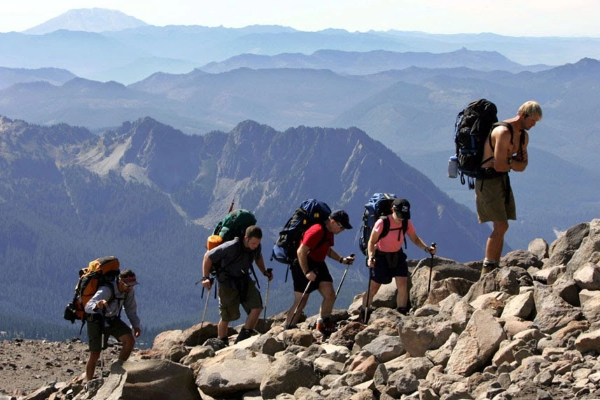Climbing walls are popular venues for both beginners and experienced climbers. Knowing what to wear can significantly enhance your climbing experience. This guide will help you choose the right clothing and gear for a successful climb.
Understanding Climbing Wall Types
Before diving into clothing choices, it’s important to understand the type of climbing wall you’ll be using. There are two main types:
Bouldering Walls: These are shorter walls (typically under 20 feet) without harnesses. Safety mats are used below.
Top-Rope Walls: These are taller and require harnesses and ropes. You will climb with a belayer.
Choosing Clothing for Both Types
While the type of climbing wall may influence specific clothing choices, some general principles apply to both styles.
Base Layers
Base layers are the first layer of clothing. They are essential for comfort.
Material Matters
Choose moisture-wicking materials. These fabrics draw sweat away from your body. Common materials include:
- Polyester
- Nylon
- Merino Wool
Fit and Comfort
Your base layer should fit snugly but not be too tight. Look for:
- Short or long-sleeve shirts
- Lightweight, breathable fabrics
- Seamless designs to reduce friction
Climbing Pants or Shorts
The right pants or shorts are crucial for mobility and comfort.
Pants
If you prefer pants, consider these features:
Stretchy Fabric: Look for materials like spandex or a cotton-blend. This allows for greater flexibility.
Durability: Choose reinforced knees to withstand wear.
Fit: Avoid overly baggy pants. They can snag on holds. Opt for tapered designs.
Shorts
If the weather is warm, shorts can be a great option. Look for:
Length: Choose shorts that are not too long or too short. A length that falls above the knee is ideal.
Material: Lightweight, breathable fabrics are best.
Pockets: Ensure pockets are secure and won’t catch on holds.
Climbing Shoes
Climbing shoes are the most critical piece of gear.
Choosing the Right Shoes
When selecting climbing shoes, consider:
Fit: Shoes should fit snugly without causing pain. Your toes should be slightly curled.
Type of Shoe:
- Neutral: Good for beginners. They provide comfort for all-day wear.
- Moderate: Ideal for sport climbing. They offer a balance of comfort and performance.
- Aggressive: Best for advanced climbers. They provide precision but may be uncomfortable for long periods.
Shoe Features
Look for shoes with:
Rubber Soles: Sticky rubber enhances grip.
Velcro or Laces: Choose based on personal preference. Velcro is convenient, while laces allow for a more customizable fit.
Harness
If you’re climbing on a top-rope wall, a harness is essential.
Choosing a Harness
Consider these factors:
Comfort: The harness should fit well and be adjustable.
Weight: Lighter harnesses are more comfortable for extended climbs.
Gear Loops: Ensure there are enough loops for your gear.
How to Wear a Harness
When putting on a harness:
Step into the leg loops.
Pull the harness up to your waist.
Tighten the waist belt and leg loops securely.
Double-check the fit before climbing.
Chalk and Chalk Bag
Chalk helps keep your hands dry.
Using Chalk
Choose chalk in the form of:
Loose Chalk: Easy to apply and control.
Chalk Balls: These are less messy and provide a consistent application.
Chalk Bag
Select a chalk bag that is:
Easily Accessible: It should hang comfortably from your waist.
Secure: Look for a closure to prevent chalk spills.
Additional Gear
Consider other items to enhance your climbing experience.
Crash Pads for Bouldering
If you’re bouldering, a crash pad can cushion falls. Choose a pad that is:
Lightweight: Easy to carry.
Durable: Able to withstand wear and tear.
Climbing Gloves
While not essential, gloves can be helpful for some climbers. They provide:
Protection: Keep your hands safe from scrapes.
Grip: Some gloves are designed for better hold on certain surfaces.
Helmet
While indoor climbing walls may not require a helmet, it’s a good idea for outdoor climbing or if you’re bouldering. Look for:
Lightweight Options: These are comfortable to wear.
Ventilation: Helps keep your head cool.
Weather Considerations
The weather can significantly affect what you wear.
Indoor Climbing
For indoor climbing, temperatures are generally controlled. However, consider:
Comfort: Wear layers that you can easily adjust.
Breathe: Choose breathable materials to stay comfortable.
Outdoor Climbing
Outdoor conditions can vary greatly. Be prepared by:
Layering: Wear a base layer, insulating layer, and a waterproof outer layer if needed.
Sun Protection: Use long sleeves and pants for protection against the sun.
Cold Weather Gear: In colder months, consider thermal layers and insulated jackets.
Accessories
Don’t overlook accessories that can enhance your comfort and performance.
Sunglasses
If you’re climbing outdoors, sunglasses are essential for protecting your eyes from UV rays. Look for:
Polarized Lenses: They reduce glare.
Secure Fit: Make sure they stay on during climbs.
Headbands or Caps
A headband can keep sweat out of your eyes, while a cap can shield you from the sun.
Hydration Gear
Staying hydrated is crucial. Consider carrying:
Water Bottles: A reusable bottle that fits in your gear bag.
Hydration Packs: Ideal for longer climbs.
Safety Tips
Regardless of your clothing choices, always prioritize safety.
Check Your Gear
Before climbing, ensure all your gear is in good condition. This includes:
Harness: Check for wear and secure fit.
Shoes: Make sure they are free from damage.
Rope and Belay Device: Inspect these for any signs of wear.
Listen to Your Body
Climbing can be strenuous. Pay attention to how your body feels. If you experience discomfort, adjust your clothing or take a break.
Conclusion
Choosing the right clothing and gear for climbing walls can greatly enhance your experience. Remember to prioritize comfort, flexibility, and safety. Whether you’re bouldering or top-roping, being well-prepared will help you focus on what really matters: enjoying the climb. Happy climbing!
Related topics:
- Best All-Mountain Wide Snowboard
- The 10 Best Adrenaline Sports
- Best All Around Skis: A Comprehensive Guide


